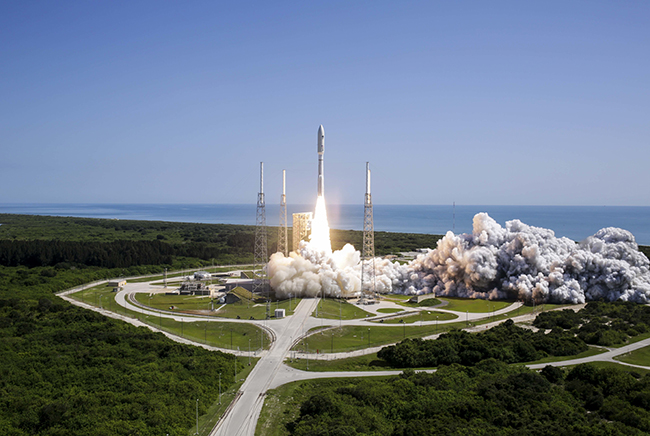
USAF's 45th Space Wing supported United Launch Alliance’s successful launch of the MUOS-5 spacecraft aboard an Atlas V rocket from Space Launch Complex 41 at Cape Canaveral AFS, Fla., on June 24, 2016. ULA courtesy photo.
The House Armed Services Committee backed the creation of a Space Corps in a bipartisan voice vote early June 13 during the markup of the 2020 defense authorization bill.
“It is not a separate service as the President had proposed,” said HASC strategic forces subcommittee chairman Rep. Jim Cooper (D-Tenn.). “It is instead a corps underneath the Air Force. It is not a $13 billion expenditure, a gold-plated plan, like had been proposed to us by the Secretary of the Air Force. It is instead a reorganization so that space professionals can be properly recognized for their skill and ability, and promoted.”
Under a compromise amendment, lawmakers propose the Space Corps be led by a Senate-confirmed, four-star commandant, answering to the Air Force Secretary, who would run the corps for a four-year term and be a full-fledged member of the Joint Chiefs of Staff. Members of other branches could volunteer to join the corps, Cooper said. The National Reconnaissance Office and National Geospatial Intelligence Agency would remain separate.
“The strategic forces subcommittee spent years reviewing the problems that we were having in National Security Space,” said Rep. Mike Rogers (R-Ala.), who championed the original Space Corps plan. “What we present to you tonight is almost identical to what passed out of this committee nearly unanimously over two years ago, and it is essential to be done.”
Rep. Don Bacon (R-Neb.) suggested that keeping Army, Navy, and Marine Corps personnel separate—as the Senate version also does—would water down the proposal. Rogers told his colleague the simpler amendment would only stand up the corps for now but that they can revisit the personnel issue next year. Cooper added there can be further talk about how to work Reserve and Guard components into the new organization.
The committee envisions the Defense Department would transfer people and assets to a Space Corps between Jan. 1, 2021, and Dec. 30, 2023. Amendment text does not address the role of Air Force Space Command, but asks the Defense Secretary to send over a detailed organizational plan for the new corps, as well as its personnel and resource requirements, by Feb. 1, 2020.
HASC drove conversation about the possible need for a Space Corps two years ago, although the plan failed to stick in the final 2018 National Defense Authorization Act. In the end, both committee chairman Rep. Adam Smith (D-Wash.) and strategic forces subcommittee ranking member Rep. Mike Turner (R-Ohio), who had expressed skepticism about a new space organization, gave the corps proposal their blessing.
The House bill differs from the Senate plan, which calls for a “Space Force,” which would likewise report through a four-star officer to the Secretary of the Air Force.
As previously reported, SASC’s solution is to upgrade the existing Air Force Space Command from a Major Command to a new service within the Department of the Air Force. The new Space Force would organize, train, and equip space warfighters.
The Senate plan divides the Air Force into two groups: “space forces” and “aviation forces both combat and service not otherwise assigned.” The bill’s text, which is still subject to amendment and/or approval by the full Senate, states: “The Air Force Space Command is hereby redesignated as the United States Space Force.”
Its commander will serve a four-year term, and lead both military and civilian Air Force employees who would help the Space Force grow “an ethos and culture for space warfighting,” the bill states. All Space Force personnel would come out of existing Air Force jobs. The Senate plan leaves to a later date the decision of whether to appoint a senior civilian to oversee the new force; it directs USAF to report back on whether a civilian under secretary for space is needed.
The SASC plan would, however, create a presidentially nominated, Senate-confirmed civilian “principal assistant to the secretary of the Air Force for space acquisition and integration.” This position would replace the existing principal assistant for space, becoming the senior space acquisition executive responsible for buying and integrating all of the service’s space systems and programs. The Air Force’s acquisition chief would give up those duties.
The principal assistant would oversee the Space Rapid Capabilities Office, the Space and Missile Systems Center, and the fledgling Space Development Agency, which is also expected to fall under the potential Space Force.
They would also chair a new Space Force Acquisition Council, comprised of the Air Force under secretary, a new assistant secretary of defense for space policy, the Space Force and Space Command Chiefs, and the National Reconnaissance Office director.
“The council shall oversee, direct, and manage acquisition and integration of the Air Force for space systems and programs in order to ensure integration across the National Security Space enterprise,” the bill states. The panel would meet at least monthly and submit quarterly reports to Congress through early 2025. Briefings from the Air Force Secretary are also required every quarter for two years, starting in spring 2020.
House lawmakers similarly suggest planning for a “separate, alternative acquisition system for defense space.”
Cost estimates for a new armed service or corps vary widely. The Trump administration has estimated a sixth service will cost $2 billion over five years and include 15,000 to 20,000 staff. The Congressional Budget Office estimated the move would cost $1.1 billion to $3 billion in one-time expenses plus $820 million to $1.3 billion a year to operate, with 4,100 to 6,800 new management and overhead positions.
The SASC bill withholds 2020 funding until the air service Secretary briefs lawmakers on its progress to stand up a Space Force and the new principal assistant job.